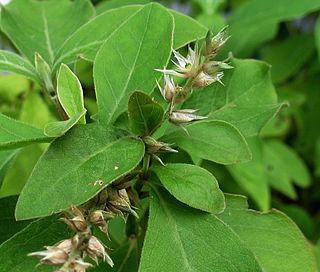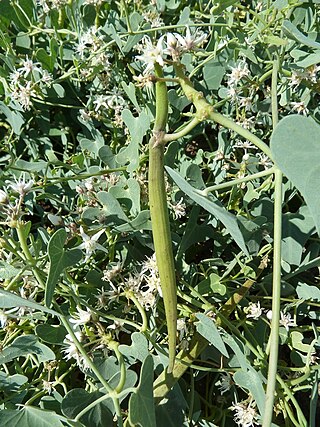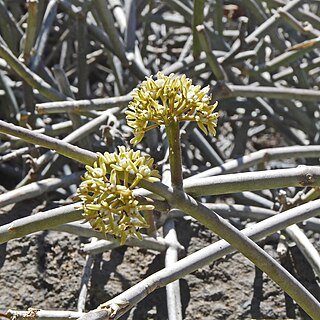
The conservation status of a group of organisms indicates whether the group still exists and how likely the group is to become extinct in the near future. Many factors are taken into account when assessing conservation status: not simply the number of individuals remaining, but the overall increase or decrease in the population over time, breeding success rates, and known threats. Various systems of conservation status exist and are in use at international, multi-country, national and local levels as well as for consumer use.

Cynanchum is a genus of about 300 species including some swallowworts, belonging to the family Apocynaceae. The taxon name comes from Greek kynos and anchein, hence the common name for several species is dog-strangling vine. Most species are non-succulent climbers or twiners. There is some evidence of toxicity.

An IUCN Red List Critically Endangered species is one that has been categorized by the International Union for Conservation of Nature as facing an extremely high risk of extinction in the wild. As of 2021, of the 120,372 species currently tracked by the IUCN, there are 8,404 species that are considered to be Critically Endangered.

Notiosorex cockrumi, also called Cockrum's gray shrew or Cockrum's desert shrew, is a tiny species of shrews named in 2003. This red-toothed shrew, which is as light as a penny, is the first new mammal species from Arizona since 1977. Its range extends from Arizona to central Sonora, Mexico.
Bauhinia haughtii is a species of plant in the family Fabaceae. It is found only in Ecuador. Its natural habitats are subtropical or tropical moist lowland forests and subtropical or tropical moist montane forests.
Swartzia haughtii is a species of flowering plant in the family Fabaceae. It is found only in Ecuador. Its natural habitat is subtropical or tropical moist lowland forests.
Grias haughtii is a species of woody plant in the Monkeypot family Lecythidaceae. It is found only in Colombia in non-flooded lowland forests. Its most remarkable feature is its leaves, which can be up to 5.5 feet in length by 16.5 inches in width. It also produces exceptionally large seeds, up to 2.7 inches in length by one inch in diameter.

Achyranthes mutica is a species of plant in the family Amaranthaceae. It is endemic to Hawaii. It is a perennial shrub that grows up to 2 ft (0.61 m) tall. Its natural habitats are dry forests and subtropical or tropical dry shrubland. It is threatened by habitat loss.
Austroblechnum divergens, synonyms including Blechnum divergens, Blechnum rimbachii and Blechnum floresii, is a species of fern in the family Blechnaceae.
Euphorbia rubrostriata, synonym Euphorbia mainiana, is a species of plant in the family Euphorbiaceae. It is endemic to Madagascar. Its natural habitats are subtropical or tropical dry shrubland and rocky areas. It is threatened by habitat loss.
Cynanchum gentryi is a species of plant in the family Apocynaceae. It is endemic to Ecuador. Its natural habitat is equatorial moist lowland forests. It is threatened by habitat loss.
Monnina haughtii is a species of plant in the family Polygalaceae. It is endemic to Ecuador.
Aristolochia preussii, synonym Pararistolochia preussii, is a species of plant in the family Aristolochiaceae. It is native to Cameroon, Equatorial Guinea, Gabon, and Ivory Coast. Its natural habitat is subtropical or tropical dry forests. It was assessed as "critically endangered" and threatened by habitat loss in the 2000 IUCN Red List, where it is said to be native only to Cameroon. As of February 2023, Plants of the World Online gives it a wider distribution.
Phyllanthus pavonianus, synonym Phyllanthus haughtii, is a species of plant in the family Phyllanthaceae. It is native from south Ecuador to north-west Peru. Its natural habitat is subtropical or tropical moist montane forests. Under the synonym Phyllanthus haughtii, it has been regarded as "endangered".
Rinorea haughtii is a species of plant in the Violaceae family. It is endemic to Colombia.

Cynanchum socotranum, synonym Sarcostemma socotranum, is a species of plant in the family Apocynaceae. It is endemic to Socotra Island, south of Yemen. Its natural habitat is subtropical or tropical dry shrubland.
Justicia harlingii is a species of plant in the family Acanthaceae. It is endemic to Ecuador. Its natural habitat is subtropical or tropical moist montane forests. It is threatened by habitat loss.

Cynanchum acutum is a species of climbing vine swallowworts native to Europe, Africa, and Asia.
Dactyladenia hirsuta is a species of plant in the family Chrysobalanaceae. It is endemic to Ivory Coast and Ghana. Its natural habitats are wet evergreen forests. It is threatened by extensive logging of its habitat, the effects of mining and the establishment of commercial plantations.

Cynanchum daltonii, synonym Sarcostemma daltonii, is a species of flowering plants of the family Apocynaceae. The species is endemic to Cape Verde. The specific name refers to Joseph Dalton Hooker. The species was named by Joseph Decaisne, as Sarcostemma daltonii, in 1849. Its local name is gestiba. The plant is used in traditional medicine to relieve and treat dental problems.







